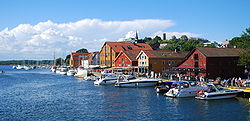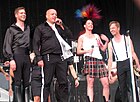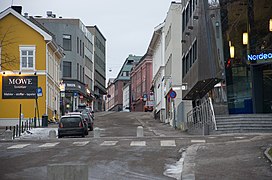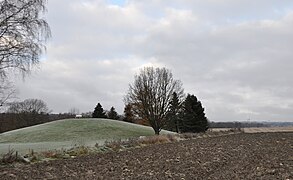Tønsberg
Tønsberg
Tunsberg (historic name) | ||
|---|---|---|
Region Eastern Norway | | |
| County | Vestfold | |
| District | Jarlsberg | |
| Municipality | Tønsberg Municipality | |
| Established as | ||
| Kjøpstad | c. 871 | |
| Area | ||
| • Total | 26.31 km2 (10.16 sq mi) | |
| Elevation | 10 m (30 ft) | |
| Population (2023)[2] | ||
| • Total | 55,387 | |
| • Density | 2,105/km2 (5,450/sq mi) | |
| Demonym(s) | Tønsbergensar Tønsbergenser | |
| Time zone | UTC+01:00 (CET) | |
| • Summer (DST) | UTC+02:00 (CEST) | |
| Post Code | 3111 Tønsberg | |
Tønsberg (pronounced [ˈtœ̂nsbær(ɡ)] ⓘ), historically Tunsberg, is a city[1] in Tønsberg Municipality in Vestfold county, Norway. It is located about 102 kilometres (63 miles) south-southwest of the capital city of Oslo on the western coast of the Oslofjord near its mouth onto the Skagerrak. The city is the most populous metropolis in Vestfold county. Tønsberg also serves as the administrative centre for Vestfold county and the seat of the County Governor of Vestfold og Telemark.[4]
Tønsberg is generally regarded as the oldest city in Norway, founded in the 9th century.

The 26.31-square-kilometre (6,500-acre) city has a population (2023) of 55,387 and a
The city of Tønsberg was established as a municipality on 1 January 1838 (see
The city is home to Tønsberg Fortress on Slottsfjellet ("Castle Mountain"), which includes ruins from Castrum Tunsbergis, Norway's largest castle in the 13th century. An outdoor music festival is held at Tønsberg Fortress every July.[8][9][5] Tønsberg is also home of Oseberg Mound, where the 9th-century Oseberg Ship was excavated.
General information
Name
The Old Norse name of the town was Túnsberg. The first element is the genitive case of tún (n) which means "fenced area", "garden", or "field around a dwelling". The last element is berg (n) which means "mountain" or "rock". The name originally referred to the fortifications on Slottsfjellet. The old spelling of the name has been retained in the name of the local diocese, Tunsberg bispedømme.[10]

Coat of arms
For a long time, the city did not have a formal coat of arms, but instead an old medieval seal dating back to 1349 was used in its place. The blue and white circular seal shows the Tønsberg Fortress surrounded by a ring wall on a mountain with the sea in front. There is also a longship in the water in front of the fortress. Around the seal are the Latin words SIGILLVM BVRGENSIVM D'TVNESBER which means "This is the seal of Tunsberg". The seal was also used for Tønsberg Municipality until 2020.[4][11][12]
History
Viking Age


Tønsberg is the oldest city in Norway,[13][14]: 230 [15][16] founded by Harald Fairhair in the 9th century.[17] It was also an ancient capital of Norway.[18] The first time the town was mentioned by a contemporary writer was in 1130. According to Snorri Sturluson, Tønsberg was founded before the Battle of Hafrsfjord, which, according to Snorri, took place in 871. The year of the battle is disputed and most current historians believe it was closer to 900. If it took place in 871, this makes Tønsberg one of the oldest present Scandinavian cities. It was based upon this that the city's 1000 years jubilee was celebrated in 1871, and 1100 years jubilee in 1971. The archaeological excavations conducted in 1987–88 underneath the monastery ruins revealed several Viking graves which have served to confirm the earlier age of the original settlement.[19]
The King or his ombudsman resided in the old Royal Court at Sæheimr, today the Jarlsberg Manor (Norwegian: Jarlsberg Hovedgård), and on the farm Haugar, (from the Old Norse word haugr meaning hill or burial mound), which can be assumed to have been Tønsberg's birthplace. Haugar became the seat for the Haugating, the Thing for Vestfold and Norway's second most important place for the proclamation of kings. The site had probably been named after two Viking Age mounds, which tradition links to two sons of King Harald I, Olaf Haraldsson Geirstadalf, who was king in Vestfold, and his half-brother, Sigrød Haraldsson, King of Trondheim. Both are presumed to have fallen in battle at Haugar against their half-brother Eric Bloodaxe and to have been buried on the same spot.[20]
Slottsfjellet (Castle Mountain), north of the city centre, made for a near impregnable natural fortress. During the
Whaling epoch


The center of the world's modern whaling industry was concentrated in the cities of Tønsberg and neighboring Sandefjord and Larvik, all of which were the dominant whaling towns in Norway.[23]: 25 While whalers from Sandefjord established the first whaling station in the Faroe Islands, whalers from Tønsberg initiated whaling in Iceland and the Hebrides.[23]: 84
During the 1850s, Tønsberg turned into a base of operation and source of expertise for whalers in the
The first whaling ventures to Antarctica was led by engineer Henrik Henriksen of Tønsberg.[26] Henrik Johan Bull was another noted whaler from the city, known for his expeditions to Antarctica. Bull traveled from Australia to Tønsberg in order to learn from local whaler Svend Foyn, who is recognized as the pioneer of the modern whaling industry.[27]
One of the city's most prominent residents,
World War II
During the
Geography

Tønsberg is a city southeastern in Vestfold County, on the western shore of the Oslofjord. Tønsberg lies north of Færder, south of Horten, and north-east of Sandefjord. It is the ninth-largest city in Norway (by population).[2] The city center lies just north of Nøtterøy Island.[4]
Tønsberg Station is 5–10 minutes walking from the main square in the city centre, known as Torvet. From the main square is a few hundred meters along Rådhusgaten to the waterfront Tønsberg Wharf ("Tønsberg Brygge"), where most cafes, bars and restaurants are located. Just south of Tønsberg are the islands of Nøtterøy and Tjøme, which are tourist destinations.[32]
The highest point in the city of Tønsberg is the 75-metre (246 ft) tall Frodeåsen hill on the north side of the city.

Nature preserves
Tønsberg and its immediate surroundings is home to five nature preserves:[4]

- Akersvannet (wetland), on the border with Sandefjord
- Bliksekilen (wetland)
- Gullkronene (deciduous forest)
- Ilene (wetland)
- Presterødkilen (wetland)
There is also a plant preserve at Karlsvika where the goal is the preservation of the threatened species fineleaf waterdropwort (Oenanthe aquatica), a rare species in Norway.[4]
Government
From 1838 until 1988, the city of Tønsberg was a self-governing city within Norway. Since 1988, the city has been part of a much larger Tønsberg Municipality. The city/urban area is no longer self-governing, but rather the entire municipality is governed by a mayor and municipal council.
Demographics
| Historical population | ||||||||||||||||||||||
|---|---|---|---|---|---|---|---|---|---|---|---|---|---|---|---|---|---|---|---|---|---|---|
| Year | 1801 | 1815 | 1825 | 1835 | 1845 | 1855 | 1865 | 1875 | 1891 | 1900 | 1910 | 1920 | 1930 | 1946 | 1951 | 1960 | 1970 | 1980 | 2000 | 2009 | 2020 | 2023 |
| Pop. | 1,543 | 1,490 | 1,907 | 1,970 | 2,245 | 2,874 | 4,541 | 5,174 | 7,215 | 8,611 | 9,769 | 12,568 | 11,997 | 11,883 | 12,208 | 12,591 | 11,284 | 9,247 | 43,346 | 47,465 | 53,018 | 55,387 |
| ±% p.a. | — | −0.25% | +2.50% | +0.33% | +1.32% | +2.50% | +4.68% | +1.31% | +2.10% | +1.98% | +1.27% | +2.55% | −0.46% | −0.06% | +0.54% | +0.34% | −1.09% | −1.97% | +8.03% | +1.01% | +1.01% | +1.47% |
| Source: Statistics Norway[33][34] and Norwegian Historical Data Centre[35] | ||||||||||||||||||||||
The whole urban area of the city of Tønsberg is the 9th most populous city/urban area in Norway and the largest city in
Sport
Tønsberg hosted a round of the powerboating UIM F2 World Championship from 2014 - 2018.
Tourist sites

Perhaps the most important landmark in the town is Slottsfjellet, the tower standing on the hill. It was erected in 1888 as a memorial to Tønsberg Fortress (Tunsberg festning), the old fortress, of which just fragmentary ruins remain today. Below the mountain there is a museum dedicated to "Slottsfjellet" and Tønsberg. There are several exhibitions here about whaling and the fortress, Tønsberg Fortress. Several streets in the town are named after old kings of Norway.[38]

Other notable tourist sites include:
- Haugar Art Museum (Haugar Vestfold Kunstmuseum), located in the former Seamen's School in the middle of Tønsberg, the brick building was built 1918–1921. The museum was established in 1993 as a foundation created by Vestfold county and municipality of Tønsberg. The museum is a division of Vestfold Museum (Vestfoldmuseene). Haugar Vestfold Art Museum is located in the parkland between the site of the ancient assembly of Haugating and the two Viking era mounds.[39]
- Foynegården, the city's best-preserved merchant's yard. Foynegården is the site of a patrician houses from the 1700s where Svend Foyn was born in 1809.
- Ruins of St. Olav's Church (Olavskirken), a former monastery founded in 1191, located near the current Tønsberg Library.[40]
- Ruins of St Michael's Church (Mikaelskirken), ruins that are still visible on top of Castle Mountain by Tønsberg Fortress. The church was mentioned among the royal chapels. It is believed to have been destroyed in 1503 when Swedish soldiers razed fortifications.[41]
- Sem Church (Sem kirke), Vestfold's oldest stone church built before 1100 in the Romanesque style, located near the Jarlsberg Estate, just west of the city of Tønsberg[42]
- Tønsberg Cathedral (Tønsberg domkirke), a brick church from 1858 with pulpit from 1621 and an altarpiece from 1764.[43]
- Slottsfjell festival, one of the biggest happenings in Tønsberg through the year. People all over the country come to Tønsberg to participate, this festival is one of Tønsberg newly landmarks.
Oseberg Mound

Tønsberg is the site of
When unearthed, the ship was buried in blue clay and covered with stones beneath the 6-metre (20 ft) high Oseberg Mound.[14]: 85
Economy

Tønsberg is mostly a shopping town and an administrative centre. It is also noted especially for its
Transport
The city is served by the railway line Vestfoldbanen, which runs in a loop through the city before reaching Tønsberg Station.
In popular culture
Tønsberg has been featured as a location in several films, most notably those set in the
Tønsberg is also featured in the 2010 game
Notable people




Royalty
- Bjørn Farmann (died ca.930), the King of Vestfold who founded Tønsberg
- Magnus VI of Norway(1238–1280), the King of Norway (as Magnus VI) from 1263 to 1280
- Margaret, Maid of Norway (1283–1290), the Queen-designate of Scotland from 1286
- Else Werring (1905–1989), a Norwegian royal hostess and Chief Court Mistress from 1958
Public Service & Business
- Cecilie Christine Schøller (1720–1786), a socialite who built Stiftsgården, a royal residence
- Carl Peter Stoltenberg (1770–1830), a merchant and representative at Norwegian Constituent Assembly
- Adrian Benjamin Bentzon (1777–1827), the Governor of the Danish West Indies from 1816 to 1820
- Gregers Winther Wulfsberg (1780–1846), a jurist and representative at the Norwegian Constituent Assembly
- Svend Foyn (1809–1894), a shipping and whaling magnate who introduced sealing to Vestfold
- Johan Henrik Dietrichs (1809-1886), a merchant and mayor of the town
- prime minister of Norwayfrom 1884 to 1889
- Wilhelm Wilhelmsen (1839–1910), a shipping magnate and founder of the Wilh. Wilhelmsen Shipping Company
- Henrik Johan Bull (1844–1930), a whaler and pioneer Antarctic explorer
- brothers Peter Christophersen (1845–1930) & Søren Andreas Christophersen (1849–1933), diplomats in Argentina
- Niels Johan Føyn (1860–1945), a meteorologist
- Norwegian American mathematician
- Ditlef Hvistendahl Christiansen (1865–1944), a Norwegian Supreme Court Justice from 1911-1936
- Ole O. Lian (1868–1925), a politician and leader of the Norwegian Confederation of Trade Unions
- Norwegian Americanarchitect
- Ole Aanderud Larsen (1884–1964), a ship designer who designed the Endurance
- Eugène Olaussen (1887–1962), a newspaper editor and politician (from communist to Nazi)
- Arnold Rørholt (1909–1986), a jurist and refugee worker
- Ebba Lodden (1913–1997), a civil servant, politician, and first female County Governor
- Jan Mehlum (born 1945), an author and academic who comes from Tønsberg
- Laila Riksaasen Dahl (born 1947), a theologian and bishop of the Diocese of Tunsberg from 2002-2014
- Jan Otto Myrseth (born 1957) a prelate and current Bishop of Tunsberg
- Per Arne Olsen (born 1961), a politician and Mayor of Tønsberg from 2003 to 2009
- Reidar Hjermann (born 1969), a psychologist and former Children's Ombudsman of Norway
- Joshua French (born 1982), a Norwegian-British murderer convicted in the Congo who grew up in Re
The Arts


- Mathias Stoltenberg (1799–1871), a portrait painter and furniture restorer
- Clara Tschudi (1856–1945), a writer of biographies of contemporary and historical women
- Elisabeth Meyer (1899–1968), a photographer and journalist
- Thomas Thomassen (1878–1962), an actor, director, and theater manager[46]
- Per Gjersøe (1908–1980), an actor and film director[47]
- Kåre Holt (1916–1997), an author from Våle
- Per Asplin (1928–1996), a pianist, singer, composer, and actor[48]
- Kjell Heggelund (1932–2017), a literary researcher, lecturer, editor, poet, and literary critic
- Wenche Blomberg (born 1943), an author, journalist, librarian, and criminologist
- Bjørn Floberg (born 1947), an actor of film, TV, and theatre[49]
- Jahn Teigen (1949-2020), a singer, comedian, and three-time competitor in the Eurovision Song Contest
- Gro Dahle (born 1962), an author and poet who grew up in Tønsberg
- Egil Nyhus & Svein Nyhus (born 1962), twin brothers who were both illustrators
- Sturla Berg-Johansen (born 1967), a stand-up comedian who comes from Tønsberg
- Ilze Burkovska Jacobsen, (Norwegian Wiki) (born 1971), a Latvian filmmaker who lives in Tønsberg
- Lene Nystrøm (born 1973), the lead vocalist of the Danish-Norwegian dance group Aqua
- Line Horntveth (born 1974) & Martin Horntveth (born 1977) & Lars Horntveth (born 1980), siblings were all jazz musicians
- Frøy Aagre (born 1977), a jazz tenor and soprano saxophone player
- Seigmen (formed 1989), an alternative rock band that comes from Tønsberg
- Kyrre Gørvell-Dahll (born 1991) known as Kygo, a DJ, songwriter, and record producer[50]
- Adelén (born 1996), a singer
- Emma Ellingsen (born 2001), a transgender model and YouTuber



Sport
- Hjalmar Andersen (1923–2013), a speed skater who won three gold medals at the 1952 Winter Olympics
- Ronny Johnsen (born 1969), a former footballer with Manchester United F.C. who has 384 club caps and 62 with Norway, lives in Tønsberg
- Linda Cerup-Simonsen (born 1969), a sailor and team gold medallist at the 1992 Summer Olympics
- Anders Aukland (born 1972), a cross-country skier and team gold medallist, 2002 Winter Olympics
- Rune Monstad (born 1973) known as The Viking Biker, a Norwegian cyclist who cycled around the world on a 27-speed Gekko mountain bike from 2005 to 2010
- Morten Hagen (born 1974), a professional golfer
- Kristine Duvholt Havnås (born 1974), a former Norwegian team handballer, team silver medallist at the 1992 Summer Olympics, and team bronze medallist at the 2000 Summer Olympics
- Tonje Larsen (born 1975), a retired Norwegian Olympic team champion handballer
- Olaf Tufte (born 1976), a rower, firefighter, and farmer who won four Olympic medals
- John Arne Riise (born 1980), a former footballer with Liverpool F.C. who has 546 club caps and 110 with Norway, lives in Tønsberg
- Espen Bugge Pettersen (born 1980), a former football goalkeeper with 440 club caps
- Lisa-Marie Woods (born 1984), a professional football midfielder
- Kjetil Borch (born 1990), a world rowing champion and team bronze medallist at the 2016 Summer Olympics
- chess grandmaster and World Chess Champion
- Anine Rabe (born 1992), a former figure skater
- Ali Srour (born 1994) known as "Prince" Ali, a Lebanese professional boxer from Tønsberg
Gallery
-
Møllers Gaten
-
Tønsberg during winter
-
Torvgaten in the city centre
-
Tønsberg in January 1908
-
Oseberg Mound, where the 9th century 22-metre Oseberg Ship was discovered
Twin towns – sister cities
The following cities are
- Covarrubias, Spain
 Évora, Portugal
Évora, Portugal Ísafjörður, Iceland
Ísafjörður, Iceland Joensuu, Finland
Joensuu, Finland Lamia, Greece
Lamia, Greece Linköping, Sweden
Linköping, Sweden Ravenna, Italy
Ravenna, Italy Waterford, Ireland
Waterford, Ireland
References
- ^ a b In the Norwegian language, the word by can be translated as "town" or "city".
- ^ a b c d e Statistisk sentralbyrå (1 January 2023). "Urban settlements. Population and area, by municipality".
- ^ "Tønsberg, Vestfold". yr.no. Retrieved 10 February 2024.
- ^ Store norske leksikon (in Norwegian). Kunnskapsforlaget. Retrieved 11 February 2024.
- ^ a b "Tønsberg - coastal charm in Norway". Archived from the original on 22 May 2014. Retrieved 10 June 2018.
- ^ "Tønsberg". Archived from the original on 8 March 2010. Retrieved 3 March 2010.
- ^ "Tønsberg | Norway | Britannica". Archived from the original on 12 June 2018. Retrieved 10 June 2018.
- ISBN 9788292284070.
- ^ "Archived copy" (PDF). Archived from the original (PDF) on 12 June 2018. Retrieved 17 June 2018.
{{cite web}}: CS1 maint: archived copy as title (link) - ^ "Bynavn" (in Norwegian). Language Council of Norway. Retrieved 10 February 2024.
- ^ "Civic heraldry of Norway - Norske Kommunevåpen". Heraldry of the World. Retrieved 10 February 2024.
- ^ "Tonsberg, Vestfold". Flags of the World. Retrieved 10 February 2024.
- ISBN 9780470972427.
- ^ ISBN 9780756693305.
- ISBN 9781742202075.
- ISBN 9780995893962.
- ^ "The Oslofjord | Norway Travel Guide". Archived from the original on 17 June 2018. Retrieved 17 June 2018.
- ISBN 9780679015581
- ^ "History of the town (County Capital Tønsberg)". Archived from the original on 22 May 2014. Retrieved 4 March 2010.
- ^ "Tønsberg History". GoNorway. Archived from the original on 8 March 2010. Retrieved 3 March 2010.
- ^ "Tunsberghus (Old Tønsberg)". Archived from the original on 11 May 2009. Retrieved 4 March 2010.
- ISBN 978-0859764513.
- ^ ISBN 9780520039735.
- ISBN 9780864426543.
- ^ Murray, John (1892). Handbook for Travellers in Norway. John Murray. p. 32.
- ISBN 9780859552417.
- ISBN 9780415970242.
- ISBN 9781136639517.
- ^ Engel, Lyle Kenyon (1963). Scandinavia: A Simon & Schuster Travel Guide. Cornerstone Library. p. 145.
- ISBN 9781786717580.
- ISBN 9781400016143.
- ISBN 9781843530541.
- ^ Statistisk sentralbyrå. "Table: 06913: Population 1 January and population changes during the calendar year (M)" (in Norwegian).
- ^ Statistisk sentralbyrå. "Folketelling 1960" (PDF) (in Norwegian).
- ^ Universitetet i Tromsø – Norges arktiske universitet. "Censuses in the Norwegian Historical Data Archive (NHDC)".
- ^ "09817: Immigrants and Norwegian-born to immigrant parents, by immigration category, country background and percentages of the population (M) 2010 - 2021-PX-Web SSB".
- ^ "Individual Speedway Norwegian Championship". Historia Sportu Zuzlowego. Retrieved 15 February 2024.
- ^ "Slottsfjellet og Tunsberg" (in Norwegian). Stiftelsen Gamle Tønsberg. Archived from the original on 24 July 2011.
- ^ "Haugar Vestfold Art Museum". Vestfoldmuseene IKS. Archived from the original on 24 September 2009. Retrieved 4 March 2010.
- ^ "Olavsklosteret i Tønsberg (Norges klostre i middelalderen)". Archived from the original on 18 May 2011. Retrieved 20 April 2011.
- ^ "Michaelkirken". De gamle kirkene i Tønsberg. Archived from the original on 2 September 2016. Retrieved 1 September 2016.
- ^ "Sem kirke (Kirkebygning og kirkekunst" (in Norwegian). Archived from the original on 1 October 2011.
- ^ "Tønsberg domkirke (Norsk Folkemuseum". Archived from the original on 3 April 2012. Retrieved 20 April 2011.
- ^ "Oseberghaugen – Royal mound in Tønsberg (Attractions in Tønsberg)". Archived from the original on 17 July 2011. Retrieved 3 March 2010.
- ^ a b c Bacon, Thomas (5 May 2019). "[SPOILER] In Avengers: Endgame Pays Off Original Thor & Captain America Films". Screen Rant. Archived from the original on 11 May 2019. Retrieved 10 June 2019.
- IMDb. Retrieved 4 February 2021.
- IMDb. Retrieved 4 February 2021.
- IMDb. Retrieved 4 February 2021.
- IMDb. Retrieved 4 February 2021.
- IMDb. Retrieved 4 February 2021.
- ^ "Samarbeid og prosjekter" (in Norwegian). Tønsberg kommune. Archived from the original on 2 February 2009. Retrieved 14 January 2009.
External links
 Vestfold travel guide from Wikivoyage
Vestfold travel guide from Wikivoyage Tønsberg travel guide from Wikivoyage
Tønsberg travel guide from Wikivoyage- Tønsberg Navigasjonsskole
- Haugar Art Museum










